Interdisciplinary Ideas
Whole-Class Discussion Strategies That Engage Students and Enhance Understanding
Science Scope—September/October 2020 (Volume 44, Issue 1)
By Katie Coppens
Much emphasis is put on helping students express their knowledge in written form. However, it is also important to teach students how to prepare for discussions as both a speaker and a listener. This begins by creating a classroom culture in which students know how to ask quality questions, feel comfortable sharing their understanding, and value listening to and learning from each other.
Constructing quality questions is an important skill that benefits all students. Some discussion strategies that emphasize open-ended questions and a culture of collaborative learning are the Harkness method and the Socratic seminar (also known as a Socratic circle or Socratic discussion). The Harkness method is based on Edward Harkness’ philosophy of students collaborating through an oval table discussion to better understand a concept (Phillips Exeter Academy 2019). The Socratic seminar is inspired by Socrates’ examination of personal beliefs through discourse and deep question asking, often through the lens of a common text (Filkins 2019). These student-led discussion methods can be applied to any content area and often include students preparing for the discussion and setting pre-established norms around speaking and listening.
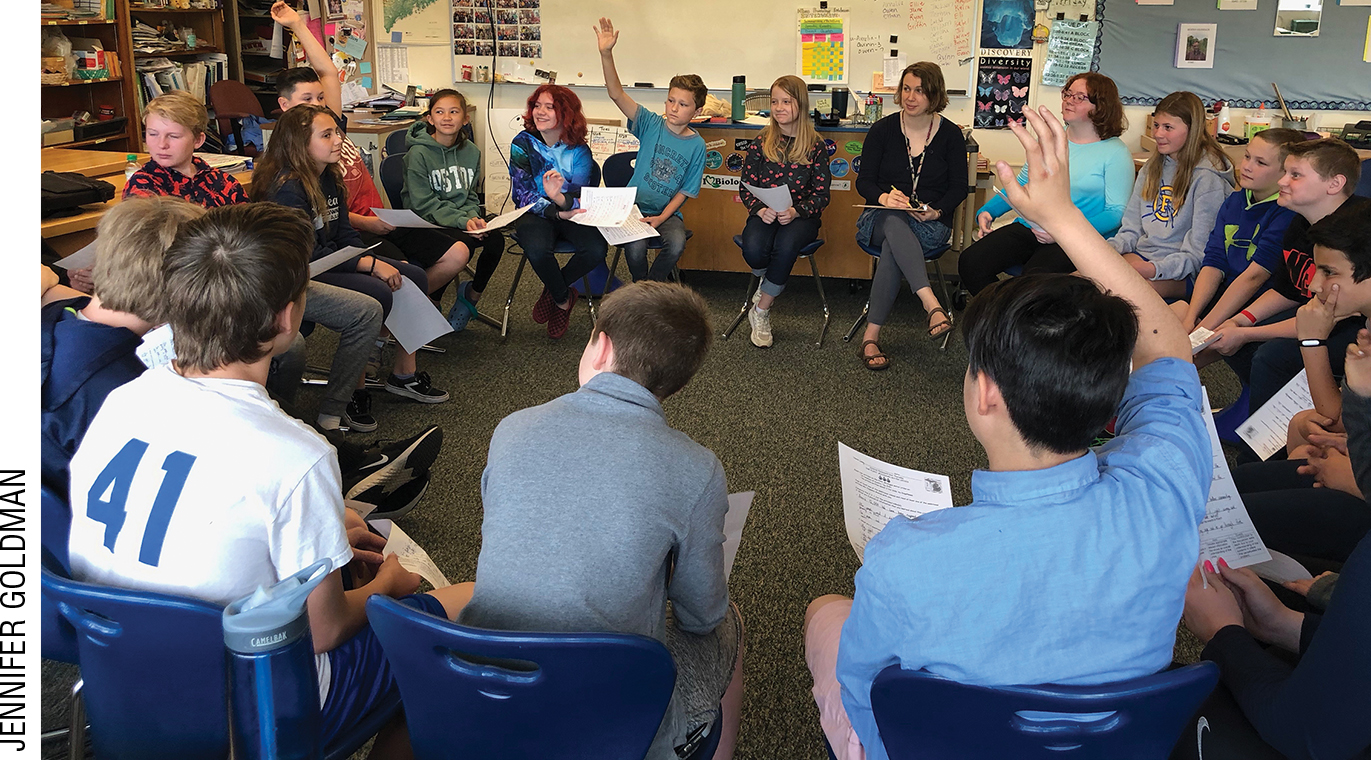
A science class using the Socratic and spider web discussion strategies
I used a whole-class discussion strategy during our ecology unit to help my students better understand the water crisis in Flint, Michigan; to encourage critical thinking; and to learn from one another. To help prepare my students, I first gave an overview of the events in Flint by showing a short documentary by the BBC News (2016). For homework, I posted website and video links on Google classroom that were chosen on the basis of their source reliability, the accessibility of the reading level, and a high interest level of the content. Students used these websites and videos to complete a 3-2-1 assignment (see Figure 1), which helped them prepare for the discussion (the “3” stands for three pieces of information that they learned, the “2” stands for two questions that they have based on the reading, and the “1” stands for one emotion that they felt when they learned about the topic). Students read two news articles that were the same for everyone, then chose between at least one article and at least one video from a list that I curated for them. When introducing the assignment, I modeled how to write open-ended questions such as “What will the long-term effects of lead poisoning be on the community?” Such questions are more thought provoking than “In what year did the crisis first begin?” because they allow students to expand on answers. Student choice was built into this assignment by having a range of topics that students could learn more about, such as a timeline of events for the crisis, Flint’s history, lead poisoning, and Legionnaire’s disease. Students were given three days for this homework assignment so they could go deeper into their exploration of topics. If homework is not the best option for the class, the 3-2-1 assignment could also be given to students as classwork.
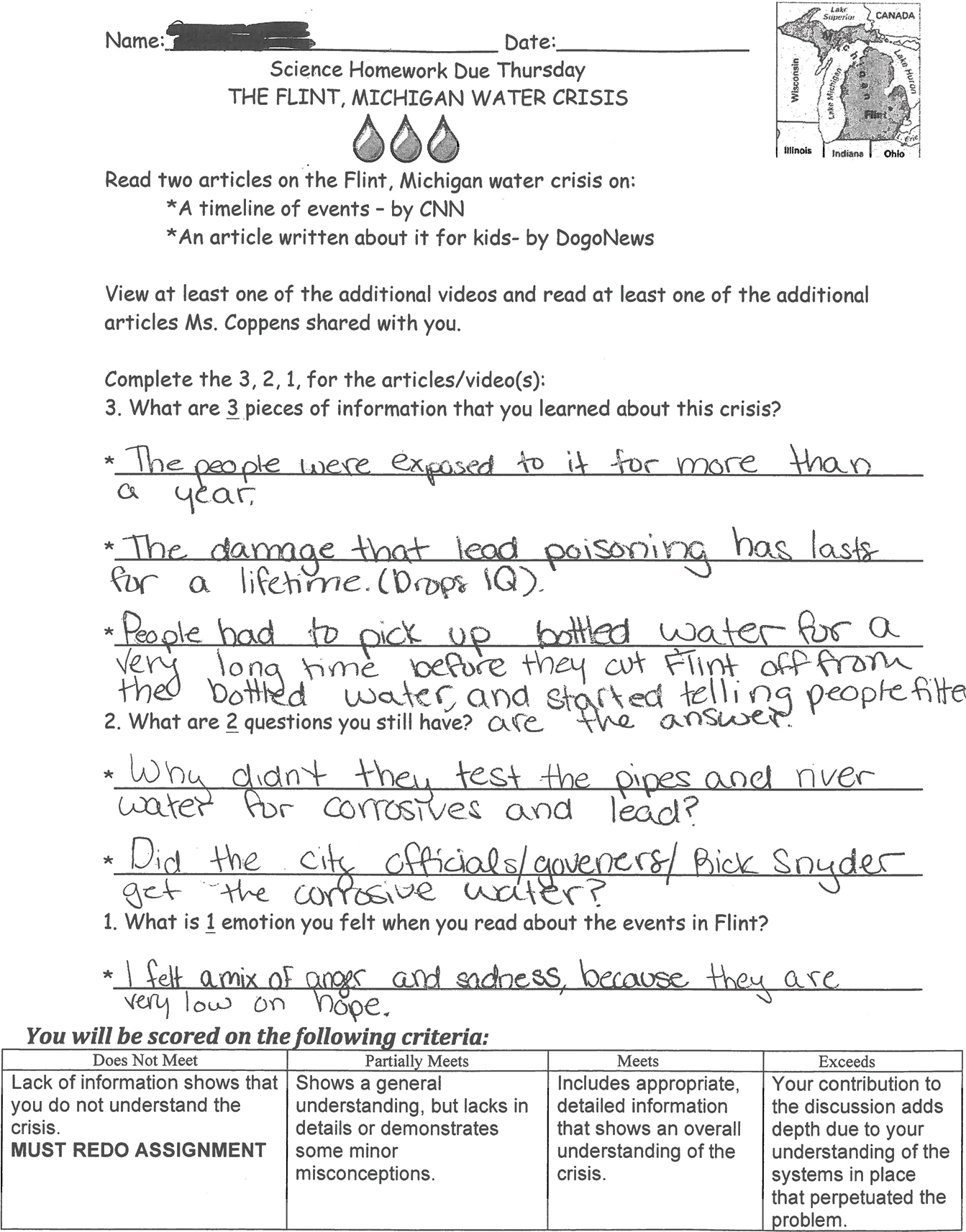
The 3-2-1 science homework assignment
On the day of the Flint discussion, I used an additional discussion strategy called the spider web discussion method. A spider web discussion is when a teacher observes a discussion with little to no interference and makes a visual that shows the sequence of the conversation. One of the benefits of visualizing a discussion is that it creates accountability, which can encourage student participation (Wiggins 2017).
Alexis Wiggins (2017) uses an acronym of SPIDER to help students better understand the goal of the spider web method. The “S” stands for synergy and the emphasis on being a balanced team during the discussion. The “P” stands for practiced because this process is reflected and improved on through continued practice. The “I” stands for independent, which represents students navigating the conversation without teacher intervention. The “D” is for developed, which is the goal of having the conversation build and have depth. The “E” stands for exploration and Wiggins’ belief that this should be approached as a discussion-based exploration of a topic. Finally, the “R” stands for rubric. Wiggins’ believes that the class should be given clear expectations before the discussion begins. She also believes that the class should be given one grade that students reflect on and determine collaboratively, of which the teacher chooses to agree with or adjust. Wiggins believes that the group grade is an important part of the process, but that it is a teacher’s choice to include it in the grade book. In her book The Best Class You Never Taught: How Spider Web Discussion Can Turn Students into Learning Leaders, Wiggins (2017) compares the discussion-based exploration and group grade with a soccer team’s combined effort to score a goal. She expands the analogy by reminding the class that much like a coach is on the sidelines during the game, she is an observer on the sidelines during the discussion. Wiggins’ acronym comes together to describe the method as a synergetic practiced independent developed exploration with a rubric.
These various approaches of creating a student-led, whole-class discussion were applied to my sixth-grade science classroom by first moving the desks to the perimeter of the classroom and putting the chairs in a circle in the center of the room. With my students’ 3-2-1 homework assignment in hand, I explained that the class would have 25–30 minutes to discuss the topic of the water crisis in Flint and that my role would be to listen to student responses and to create a visual web of the conversation. After explaining the roles and purpose of the activity, which is to demonstrate our knowledge of the water crisis and learn from one another, I added that the conversation could take any tangent as long as it stayed under the umbrella of the water crisis in Flint. I also explained that we would debrief and reflect on the conversation after it was over, which Wiggins (2017) believes is an essential part of this approach.
I challenged the class to be mindful of how many times people had already talked when they chose whom to call on next. I felt it was important to explain that it can be tempting to call on friends, but that the goal is to have a balanced conversation in which they work as a team to learn from everyone. I then asked who would like to start the conversation with a comment and/or an open-ended question for the group.
During a discussion, Wiggins (2017) prefers to sit in the far corner of the classroom and observe, but I prefer to sit in one of the chairs in the circle. I had a clipboard and paper and quickly recorded students’ location in the circle, then webbed out the progression of the conversation (see Figure 2). I allowed students to choose where they sat, but an alternative method could be writing out names ahead of time on the paper and assigning seats. The teacher could also take notes on each student’s understanding and engagement. Wiggins uses a coding system where she writes an “I” next to students who interrupt or a “T” if they reference the text. This documentation helps a teacher compare how students do from one discussion experience to the next and to provide student feedback.
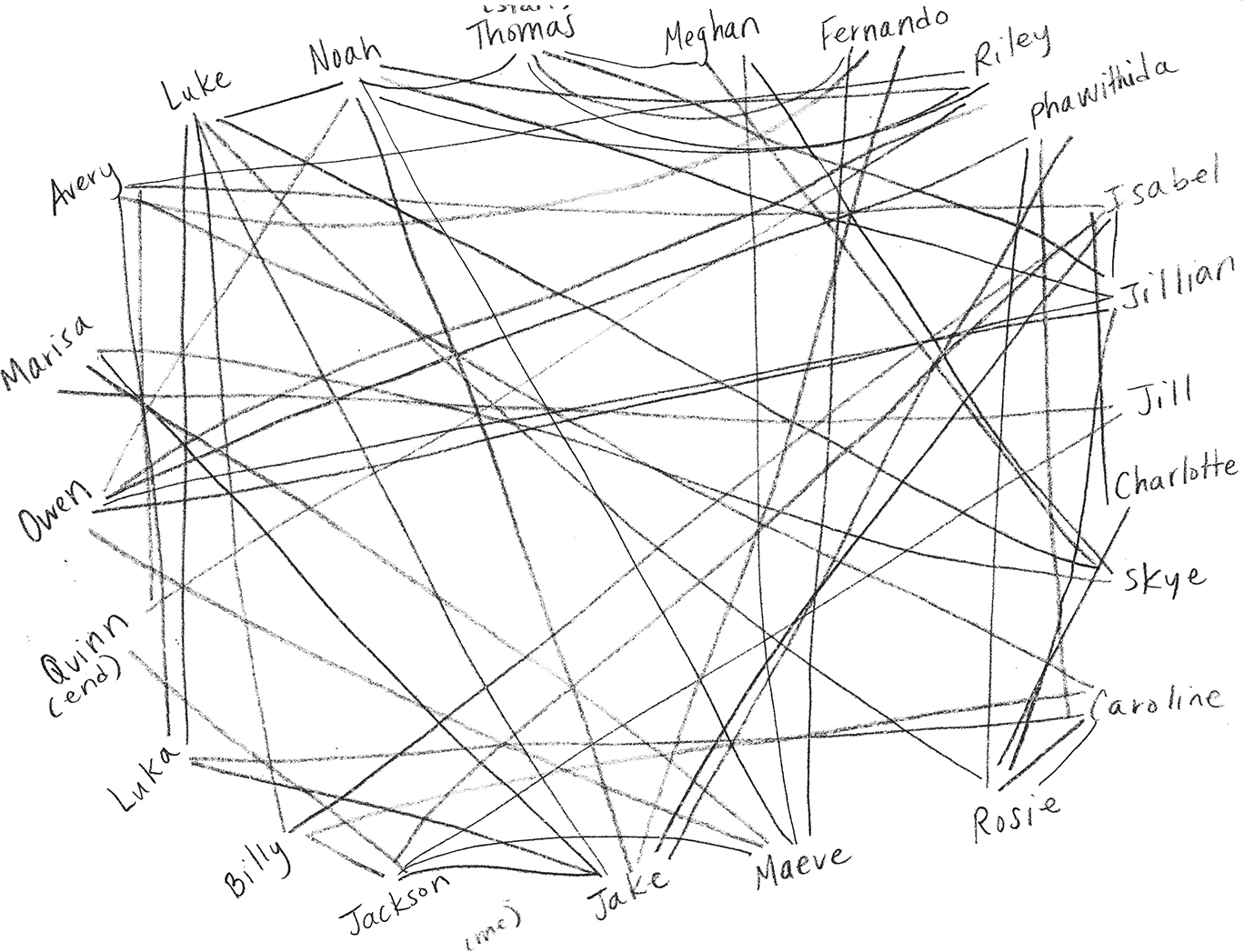
A completed diagram of a class discussion
During the conversation, some students referred to their 3-2-1 homework sheet for specific facts, but most simply talked from their memory. At one point, a student shared an inaccurate fact about the amount of lead per parts per billion. It was impressive to see the hands shoot up, followed by a student correcting the misinformation and citing the source. Other students looked visibly disappointed that they, too, knew the correct information and were not the ones to share it. As each question or response finished, at least half the hands would go up as students were ready to share their knowledge or feelings.
At the end of the discussion, I asked students to reflect on this approach. Many students said that it felt “mature,” that they liked the flexibility of having a conversation that could branch in different directions, that they enjoyed hearing from students who don’t talk as often in class, and that they liked learning from each other. An important part of the discussion was taking the time to debrief, which allowed students a chance to voice their opinion on the experience. This activity could also include an exit slip in which students self-reflect or answer a question about the content of the discussion.
Preparing for discussions
It is important to teach students how to respectfully react to the opinions, ideas, and evidence presented by their classmates. Figure 3 shows a tool by (2019) designed to help teachers prepare for discussions through asking open-ended questions. The document also models phrasing questions in a way that is respectful and nonjudgmental. Before class discussions I remind students of how to build off of what the person before them said, with sentence starters like “I have a different interpretation …” or “I agree with ___’s thinking because …” I also find it helps to give positive reinforcement for what students say during discussions and also for respectful responses. This approach reinforces Wiggins’ (2017) emphasis on giving students a “valued voice.”
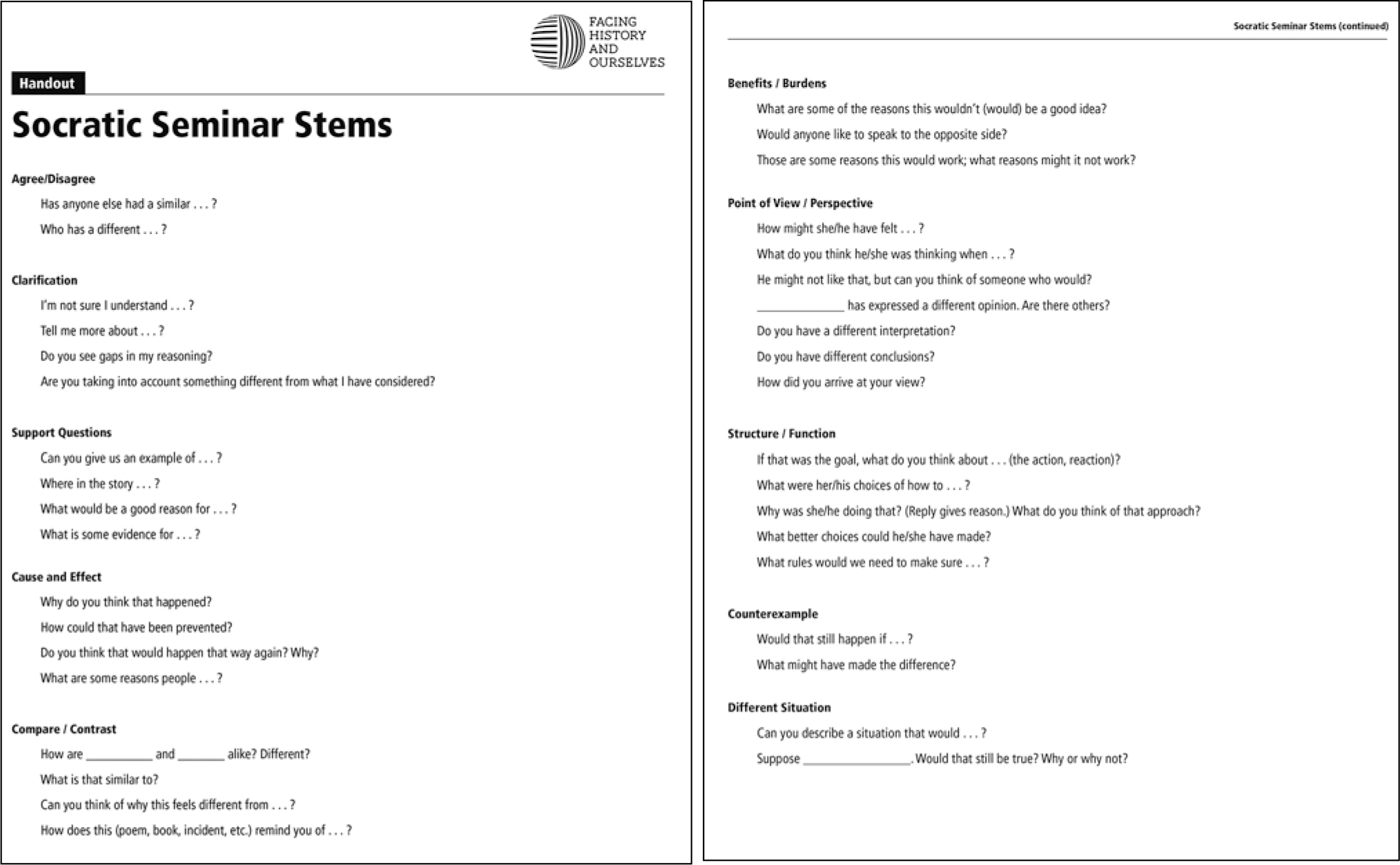
Socratic seminar stems
Differentiation tips
Hoffman (2013) recommends providing English-language learners with sentence frames (similar to the tool shown in Figure 3) to give them a starting point during a discussion. Some examples of sentence frames that could benefit all students are: “To build off of what ____ said, I think ____” or “I disagree with the statement _____ because ____” or “I agree with ____ because____.” During discussions, Hoffman recommends displaying these sentence frames somewhere that all students can see them.
Other students may struggle with public speaking. To help them, I wait to do this lesson until I know my students and talk to those whom I suspect may feel nervous so I can see how best to support them. One method is to have a discussion with the student ahead of time and make a plan that you will call on him or her to start the conversation. This allows a student to prepare for what they will say and to feel less anxious during the discussion because they have already spoken at least once. If a student is still uncomfortable talking after this option is given, I no longer push the talking aspect of the activity and instead focus on that student’s listening. To assess their understanding, they could have a follow-up conversation with me (or preferably me and one of their friends in class) or do a written reflection on their big takeaways about the topic. Although giving this written option does not help them with their speaking skills, it addresses an individual student’s needs, allows them to be an active listener in the discussion, and gives the teacher an opportunity to evaluate their understanding.
In the event that you have students who are unprepared for the discussion, you can use the fishbowl discussion method. This method involves two circles—the inner circle consists of students who are active in the discussion and the outer circle involves students silently observing the discussion. Unprepared students could be the observers who write about or orally follow up on their observations of the discussion, what they learned, and their own insight gained from the discussion.
Using the web with small groups
I also use the spider web method during small-group discussions. My students typically sit in groups of four, and I often direct them to discuss a concept that they just learned. I also ask them to apply the spider web tracking method and what they learned as speakers and listeners when engaging in a small-group discussion. I hand a sticky note to each group, and one student maps out a web for me showing the flow of their conversation (see Figure 4). My students have consistently said that knowing that their participation is being tracked encourages them to participate more and to actively listen to their peers. Although Figure 4 does not tell me the content of what they are saying, I walk around the room listening to conversations. The spider web map that they turn in provides me with a quick visual of the number of times that a student contributes to the conversation.
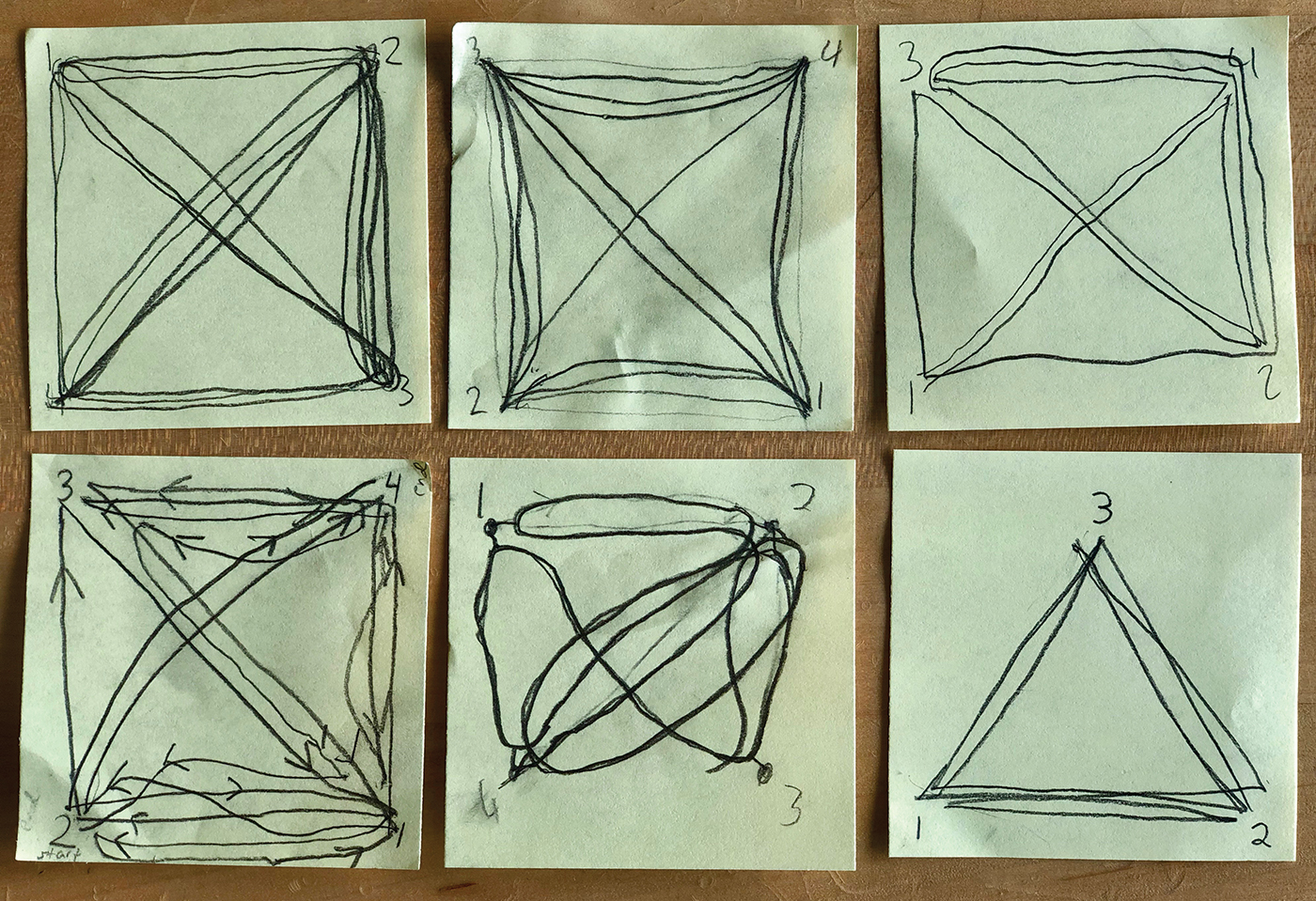
The spider web visuals that six different groups made of their small-group discussion
These discussion strategies have taught my students how to prepare for a discussion and emphasize the value that speaking and listening hold in my classroom. They have also helped students learn from one another and have provided me with opportunities to listen to my students.
Pedagogy Teaching Strategies Middle School


